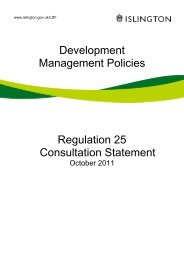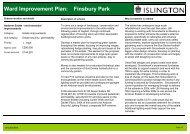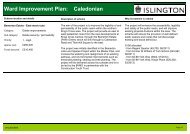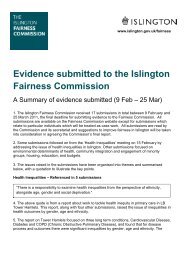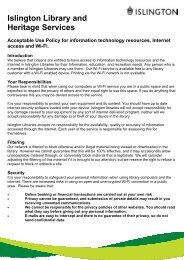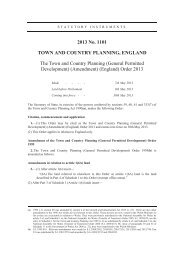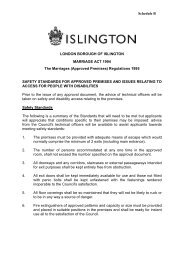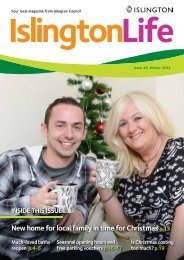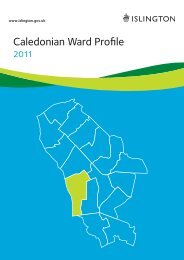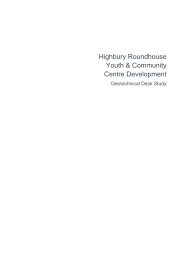Two Islingtons: Understanding the Problem - Islington Council
Two Islingtons: Understanding the Problem - Islington Council
Two Islingtons: Understanding the Problem - Islington Council
Create successful ePaper yourself
Turn your PDF publications into a flip-book with our unique Google optimized e-Paper software.
8.2. Prevailing assumptions and practices can set up barriers that prevent fair access to<br />
services and equal employment opportunities, which in turn can discriminate against<br />
people on <strong>the</strong> grounds of age, disability, gender, race, religion or belief and sexual<br />
orientation. Working with <strong>the</strong> Equality Standard enables <strong>Islington</strong> to mainstream equality,<br />
which will ensure that discriminatory barriers are identified and removed. This is achieved<br />
through <strong>the</strong> implementation of Departmental Equality Action Plans (DEAP’s) led on by<br />
each department and overseen by <strong>the</strong> Corporate Equalities team as well as <strong>the</strong><br />
undertaking of Equality Impact Assessments which assess <strong>the</strong> potential impact of a policy<br />
or project on <strong>the</strong> different equality strands.<br />
9. Crime<br />
9.1. Crime is a significant issue within <strong>the</strong> borough and affects different groups<br />
disproportionately; 81% of victims of domestic violence are women and drug misuse is<br />
higher amongst men. There is an over-representation of Black boys entering <strong>the</strong> Youth<br />
Justice System and disabled people are more worried about crime and twice as likely to be<br />
fearful of going out after dark. Young people are <strong>the</strong> main perpetrators and victims of crime<br />
and over 40% of older people feel very unsafe out after dark.<br />
9.2. An overview of <strong>Islington</strong>’s Total Notifiable Offences revealed that crime has continued to<br />
decline during 2009, with an approximate 6% reduction compared to <strong>the</strong> previous year’s<br />
figures (Apr to Dec compared to <strong>the</strong> same period in 2008). However more recently, this<br />
long-term decline in total offences has appeared to slow, suggesting that levels are<br />
beginning to plateau. Overall, <strong>Islington</strong> continues to be a high crime borough, with<br />
comparatively more crimes than any o<strong>the</strong>r London Borough with <strong>the</strong> exception of<br />
Westminster. Despite positive reductions, a number of offence categories saw increases<br />
over <strong>the</strong> last year, most notably Hate Crime (8% up), Motor Vehicle Crime (7% up) and<br />
most o<strong>the</strong>r areas of acquisitive crime (Theft & Handling offences up by 3% overall). This<br />
rise was predicted as a possible consequence of <strong>the</strong> current economic issues in <strong>the</strong><br />
country A range of activities and actions are in place to tackle <strong>the</strong> inequalities in relation to<br />
crime and safety;<br />
9.3. The Triage Programme works alongside partners in <strong>the</strong> Police service to divert potential<br />
first time entrants away from <strong>the</strong> youth justice system by offering a targeted package of<br />
support services. The programme is targeted at young people committing gravity 1 and 2<br />
level offences. Between its launch in June 2009 and Dec 2009, Triage has worked with 93<br />
young people. 10 of <strong>the</strong> 93 have been re-arrested since and dealt with via <strong>the</strong> criminal<br />
justice system; 2 o<strong>the</strong>rs were still on Police bail as of Dec 2009. This represents a<br />
relatively low rate of re-offending, and early indicators are that <strong>the</strong> Triage programme is<br />
having a significant impact on reducing first time entrants.<br />
9.4. For young people, crime & drugs <strong>the</strong>re has been a focus on reducing re-offending,<br />
preventing young people becoming victims of crime, improving attitudes towards<br />
education, and reducing <strong>the</strong> risk of young people entering <strong>the</strong> criminal justice system. The<br />
number of first time entrants to <strong>the</strong> youth justice system is improving- PNC results for<br />
2008/09 show a 15.5% reduction on <strong>the</strong> previous year while <strong>the</strong> YJB submission for Q3<br />
shows a 33% reduction – both measures are substantially better than London and YOS<br />
family comparators. The charity Chance UK aimed reducing youth crime and anti-social<br />
behaviour by providing one-to-one mentoring for children aged 5-11 with behavioural<br />
difficulties using a solution focused approach. Well over 100 children have been mentored<br />
have been mentored and 97 new mentors trained. 98% of children showed reductions in<br />
16



